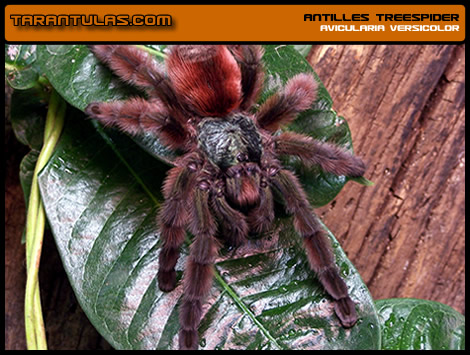Avicularia versicolor
© 2009-2010, Michael Jacobi and TARANTULAS.com
Common Name(s): Antilles or Martinique "Pink-toe" or Treespider, Martinique Red Treespider; slang: versi (VUR-see) (pl. versis)
Experience Level: Beginner to Intermediate
Range: Lesser Antilles—Martinique and Guadeloupe
Habitat: tropical forest
Habits: arboreal tarantula that lives in silk-tube retreats among palm fronds, bromeliads, etc.
Temperature & Humidity: fairly warm [75-82°F] & moderately humid [70-80% RH]
Spiderling Housing: Spiderlings may be roused in a variety of containers (see Raising Young Tarantulas), but we prefer the following set-up: a 16-24 oz. deli cup half filled with slightly damp substrate and covered with a layer of moist sphagnum moss, with a sprig of artificial plant and an insect cup lid. This type of lid and cup provides excellent ventilation, whereas there is a significant risk of having too much moisture/humidity in the standard "spiderling vial". "Versi" spiderlings have an undeserved reputation for being difficult to raise. The primary reason some keepers have had high mortality is that they are keeping them too moist and the spiders are succumbing to stagnant conditions. Yes, this is a tropical rainforest species that requires high humidity, but humidity must never be provided at the cost of good ventilation. A vial or small jar with a few pinholes is just not well-ventilated enough. These containers are great for desert and temperate species and even tropical burrowing tarantulas, but for a tropical arboreal spiderling there is too great a risk of over-dampness. Remember: it's easy to add more humidity/moisture, but very difficult to remove excess humidity/moisture. A well-ventilated container provides the opportunity for drying within 24 hours of misting, and a deep layer of substrate allows for a moisture reserve at the bottom of the strata and drier conditions above in the environment where the spider lives. Frequent feeding of small meals (one body-length cricket every 3-5 days) will keep a spider well-hydrated and minimize the risk of desiccation and allow for less frequent or less heavy misting.
Juvenile and Adult Housing: Avicularia versicolor is particularly well-suited to beautiful natural vivaria. After rearing juveniles in half-gallon or gallon jars (or Kritter Keeper™ style cages), a tall well-planted vivarium (terrarium) is an exceptional adult enclosure. See Arboreal Tarantula Husbandry for description of these enclosures.
Captive Diet: Crickets, moths, small roaches; anoles are great supplements for adult females
Special Note: The common "Pink-toe" and some other members of the genus Avicularia are known for being rare exceptions to the one spider per cage rule. These Avics can be housed communally with some success. However, Avicularia versicolor has the cannibalistic tendencies of the majority of tarantulas and cannot be raised together. Even spiderlings will soon feed on their siblings.
Comments: This technicolor species makes an excellent display tarantula. It's fairly docile, but tends to be very jumpy/flighty and difficult to handle. As mentioned in the Spiderling Housing section above, the key to raising young "versis" is to ensure they stay hydrated without causing stagnant conditions. Misting with lukewarm water (spraying enclosure/plants/silk retreat, but never the spider directly!) is the standard way to keep humidity elevated and provide droplets of water for the spider drink. However, this should be done moderately and frequently so that over-dampness does not occur. A well-ventilated cage that allows the moisture to dry within 24 hours is essential. Re-spraying to add humidity/moisture every day or so is easy; breaking down and cleaning a cage to remove soggy substrate from over watering is hard! And the latter conditions can prove fatal to your spider. In general, the humidity requirements of this species are exaggerated. A cage never need to be very humid, with condensation and dampness. If your versi is well-fed, and therefore well-hydrated, it will be more tolerant of slightly dry conditions than overly humid conditions
Additional Info: Basic Tarantula Care | Raising Young Tarantulas | Arboreal Tarantula Husbandry
References
Bagaturov, M.F. 2005.
Some notes on breeding Avicularia versicolor with comments on the hobby in Russia.
Journal of the British Tarantula Society 20(3): 78-88.
Charpentier, P. 1992.
The genus Avicularia.
Exothermae 1(1).
Eckardt, D. 1991.
The Martinique red tree spider.
Journal of the British Tarantula Society 6(3): 9-10.
Moore, M.E. 1999.
A peek into the private life of a tropical tarantula (Avicularia versicolor).
Reptile & Amphibian Hobbyist September 1999.
